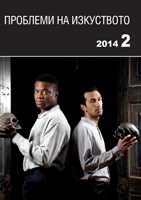Етапи в процеса на създаване на Шекспиров драматичен образ
Stages to Achieve a Shakespearean Character
Author(s): Sava DragunchevSubject(s): Cultural history
Published by: Институт за изследване на изкуствата, Българска академия на науките
Summary/Abstract: This research points out the system that would interpret the prerequisites of theatre creating today, of the educational, and the specifically individual characteristics as a starting ground for building the basic benchmarks along the actor’s training – the synthesised vocal and speech skills, the movement, analytical- and critical-thinking related competence, so that he or she can work freely in a translation-bound environment such as Bulgaria with a Shakespearean text, abundant in artistic devices offering some basic directions for the interpretation of the role. The rhythm of the language, the sound models and the actor’s wilful abiding by them, or on the contrary – wilful violation, bring plenty of interpretative information. The practical base for teaching Shakespeare today (to either students, or professional actors) brings out the generally recognised theatre categories, which need, however, refocusing in terms of this author – status, power, rhythm (including rhythm of the heart), openness of the body, physical use of space, diction, stress, etc., so that it becomes possible to adequately use blank verse, rhyme, rhythm, verse structure, meter change, metrics, scansion, pause, caesura, breath, end of sentence within a line, sharing lines between characters, transition from verse to prose and vice versa, monosyllabic vocabulary, figures of speech (alliterations, assonances, onomatopoeia, antitheses, paradoxes, contradictions, similes, hyperbolas, hendiadyses, epiphoras, anaphoras, and above all – metaphors). By knowing, recognising and embodying the right content of these devices the actor, being form responsible, can build a complicated palette of images and can create author-dictated emotions and actions in harmony with the rest of his colleagues on stage and in consonance with the director’s, the designer’s, the movement and vocal aspect of the performance. In other words – the technical Shakespeare would give way to the live Shakespeare. By cultivating taste and sense of proportion that would allow for the sensitivity and for the mind to measure the dose and the aesthetic validity of the environment on stage, and in life, the modern actor, instead of standing up in front of the colossus, can step on Shakespeare’s shoulders, armed with his voice, expression and life – Vox, Vultus, Vita – or his mind, heart and soul!
Journal: Проблеми на изкуството
- Issue Year: 2014
- Issue No: 2
- Page Range: 23-30
- Page Count: 8
- Language: Bulgarian
- Content File-PDF

